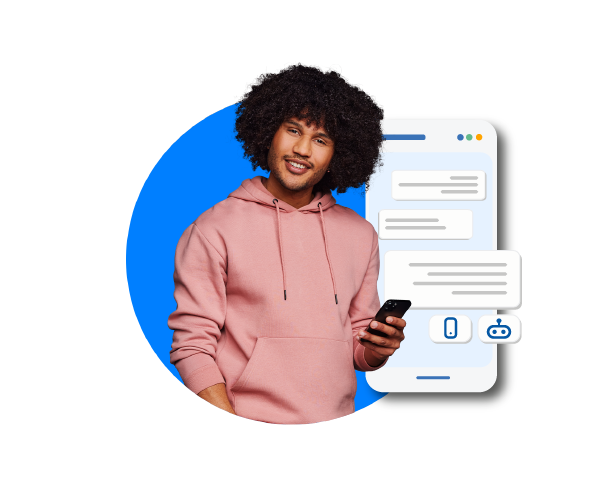What Is a Voicebot?
A voicebot is a conversational agent that uses artificial intelligence and natural language understanding (NLU) to interpret the intent and meaning in the speech of its conversational partner. We also refer to this technology as 'Conversational IVR'.
Voicebots use input voice recognition and translation (commonly referred to as speech-to-text or STT) alongside a text-to-speech (TTS) engine to understand human speech and respond using everyday language.
When you think of voicebots, your mind may instantly jump to the likes of AI voice assistants like Alexa or Siri. But in the customer service world, conversational interactive voice response (IVR) is quickly becoming one of the most utilized forms of conversational AI.
In simple terms, conversational IVR is the technology behind a voicebot, allowing callers to engage with a self-service solution with their voice. In contrast to traditional IVR, there is no static menu and callers don't have to dial in numbers. Conversational IVR can understand full sentences in voice and can even understand context. The voicebot will then reply in full sentences, allowing callers to lead the conversation.
With a voicebot, you can not only route customers to the right agent, but also facilitate service. For example, you can use conversational IVR to answer customer queries, to update customers on the status of an order, or to assist customers in updating personal information like an address or telephone number.
Traditionally with IVR, callers would have to dial in numbers (referred to as touch-tone user inputs) in order to be redirected to the right person or department. Conversational IVR offers a faster, smoother, and more personal experience for customers.
Read more: What is IVR? >
Voicebots vs Chatbots
Like a voicebot, a chatbot is an automated conversational interface powered by artificial AI, which you can use to automate and streamline your early-stage customer service interactions.
While voicebots can interpret the spoken voice and communicate in kind, chatbots are text-based messaging solutions that interpret written text and respond using text – facilitating a conversation between bot and user that mimics person-to-person messaging conversations. Since a voicebot converts speech to text and text to speech to communicate, it can use the exact same database as your AI chatbot is using.
Voicebots and chatbots both have their advantages, and you can use both to help provide customers with channels that suit their communication preferences.

What Are the Benefits of Voicebots?
Voicebots can provide several benefits to customer service teams. Let’s look at a handful of some of the biggest.
Provide a Smoother Customer Support Experience
The touch-tone method, where callers must press specific numbers in order to be connected to the right department or agent, can be irritating and time-consuming for customers.
In contrast, conversational IVR offers a more fluid form of communication, seamlessly connecting callers to the right agent or department and providing the information they need.
Since you can use the same database and dialogs as for all your other Conversational AI solutions, you guarantee the same answer on any channel. Whether a customer asks a question to your chatbot, looks it up on your dynamic FAQ page, or asks it to the voicebot; the answer will be the same. If you want to change an answer, such as opening hours, you only have to change it once and all your bots will be up-to-date.
Offer 24/7 Customer Support
Customers hate to wait. But your customer service representatives can’t always be available. Whether agents are overwhelmed by high call volumes or customers call outside of working hours, your agents’ availability and customer needs don’t always align.
Luckily, conversational IVR can offer fast, round-the-clock self-service support to customers. This ensures customers can get a response to their customer queries and issues 24/7 – without having to wait on holds for hours.
Enable Self-Service Options
Autonomous customers are happy customers. You can put conversational IVR to good use, helping customers to source information and make their own changes – such as updating an old password or canceling a subscription to a service. This helps customers feel empowered and self-sufficient and helps them swerve time-consuming conversations with customer service representatives.
Improve Employee Satisfaction Rates
In addition, voicebots can help reduce customer service teams’ workloads, reduce stress levels, and improve employee satisfaction levels. Conversational IVR takes the stress and pressure off your customer service agents by handling a high number of customer questions. This frees your agents up to focus on more complex and less tedious aspects of customer service.
Scale Without the Expense
It’s expensive to recruit and train a large number of customer service agents and ensure that there are enough people on staff to answer customer queries around the clock. In addition, voicebots help with call reduction by addressing customer questions and issues – reducing the number of lengthy and costly calls between customers and agents.
Moreover, in comparison to conversational IVR, maintaining legacy IVR systems can be expensive. Voicebots offer companies the ability to scale and meet customer support needs cost-effectively.
How to Get Started with Voicebots
Voicebots provide a more seamless, natural way for customers to communicate with technology. By reducing workloads for customer service representatives, offering 24/7 customer support, and allowing you to scale without the expense, voicebots are a smart way to address your front-line customer service needs. Head here to get started with voicebots for your business.